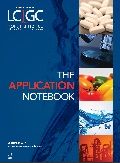Intrada SEC: GFC/GPC Silica-Diol SEC Column Designed to Work with Volatile Salts and Is MS-Compatible
The Application Notebook
Typically, silica-based size-exclusion columns require high concentrations of non-volatile salts to facilitate timely elution, and require dedicated columns for GPC or GFC applications. Addressing these issues, our new size-exclusion chromatography silica-based column utilizes volatile salts making it compatible with MSn, CAD, or ELSD; provides excellent results in aqueous and/or organic mobile phases; and offers the mechanical stability of silica-based columns.
Size exclusion chromatography is an established method to separate a mixture based on the size of a variety of large molecules, such as proteins and synthetic polymers. Polymer-based columns are commonly used today because of their chemical inertness, but they are mechanically unstable (vulnerable to swelling in certain solvents or compression under high pressure). Silica-based columns have better mechanical durability, but they require high concentrations of non-volatile salts and suffer from exposed silanols.
Here we highlight a new technology, the Intrada SEC, which utilizes a wide-pore (300 Å), silica-based particle with a diol-substituted stationary phase. This new technology enables excellent resolution in aqueous and/or organic mobile phases (GFC and GPC), the use of volatile salts, and compatibility with MS detection.
Experimental Conditions
Separations were run using Intrada SEC columns (250 × 4.6 mm, length × ID). Mobile phase conditions in figure inset.
Results and Discussion
Figure 1 shows gel filtration chromatography (GFC) of recombinant human serum albumin (rHSA) using an aqueous mobile phase with volatile salts and mass spec detection.

This chromatogram highlights the high resolution capability that Intrada SEC offers. This is the only silica-based SEC column designed specifically to use mobile phase conditions compatible with MS detection. This dramatically improves the resolution and quantification capabilities of SEC as shown here where the size of the peak of interest was characterized down to the single Dalton.
Figure 2 shows a synthetic polymer separation with gel permeation chromatography (GPC), using a purely organic mobile phase. This highlights the wide range of mobile phase options for Intrada SEC, in that a single column type is compatible in either GFC or GPC conditions.

Conclusions
Intrada SEC is truly a breakthrough for silica-diol SEC technology. It delivers outstanding performance in simple aqueous mobile phase with volatile salts making these methods MSn, CAD, or ELSD compatible. Additional benefit of using Intrada SEC is that it provides excellent separation over a wide range of mobile phases, from aqueous to organic, in either GFC or GPC conditions. Finally, Intrada SEC offers the mechanical stability of silica, expanding the range of acceptable solvents without worrying about particle swelling or compression upon high pressures. We feel that this makes this column a much better option over standard polymer-based SEC columns.

Imtakt USA
1104 NW Overton St., Portland, OR, 97210
tel. (888) 456-HPLC, (215) 775-8902, fax (501) 646-3497
Website: www.imtaktusa.com; Email: info@imtaktusa.com

SEC-MALS of Antibody Therapeutics—A Robust Method for In-Depth Sample Characterization
June 1st 2022Monoclonal antibodies (mAbs) are effective therapeutics for cancers, auto-immune diseases, viral infections, and other diseases. Recent developments in antibody therapeutics aim to add more specific binding regions (bi- and multi-specificity) to increase their effectiveness and/or to downsize the molecule to the specific binding regions (for example, scFv or Fab fragment) to achieve better penetration of the tissue. As the molecule gets more complex, the possible high and low molecular weight (H/LMW) impurities become more complex, too. In order to accurately analyze the various species, more advanced detection than ultraviolet (UV) is required to characterize a mAb sample.

.png&w=3840&q=75)

.png&w=3840&q=75)



.png&w=3840&q=75)



.png&w=3840&q=75)














